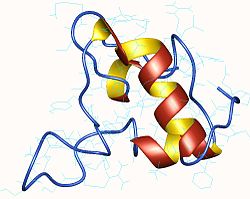
A protein is a crucial entity within the body, which consists of large and intricate molecules that serve numerous vital roles. Proteins are responsible for the organization, operation, and regulation of the body's tissues and organs. Comprised of lengthy chains, proteins consist of hundreds or thousands of smaller units known as amino acids. These amino acids, of which there are 20 distinct types, are connected together to form the protein. The specific sequence of amino acids governs the unique three-dimensional structure of each protein and determines its specialized function.[1] The combination of three DNA building blocks, or nucleotides, as determined by gene sequencing, encodes the amino acids. DNA-binding proteins have a central role in all aspects of genetic activity within an organism, such as transcription, packaging, rearrangement, replication, and repair.[2] These proteins interact with DNA to perform various functions, including regulating gene expression, maintaining the stability of the genome, and facilitating the replication of DNA during cell division. Proteins perform a diverse range of functions for the cell, including providing structural support, catalyzing chemical reactions, and regulating gene expression. Some examples of proteins and their functions include:
- Hemoglobin: A protein found in red blood cells that binds to oxygen and transports it throughout the body.[3]
- Collagen: The most abundant protein in the body, it is a structural protein that provides strength and support to connective tissues, such as skin, tendons, and ligaments.[4]
- Enzymes: These are proteins that catalyze chemical reactions, allowing them to proceed at a faster rate than they would otherwise.[5]
- Transcription factors: Proteins that can bind to particular DNA sequences and control the process of gene transcription, leading to the production of mRNA.[6]
- Ion channels: Proteins that form pores in cell membranes, allowing ions to pass through and regulating the flow of electrical signals in cells.[7]
Proteins and geneticsProteins and genetics
The majority of genes carry the necessary instructions to produce functional protein molecules. Some genes, however, produce regulatory molecules that assist in the assembly of proteins within the cell. The process of transforming genetic information into proteins is intricate and tightly regulated within each cell, involving two key steps: transcription and translation.[8] Transcription involves the copying of the DNA sequence of a gene into a molecule called messenger RNA (mRNA). This mRNA then transports the genetic information from the nucleus to the cytoplasm of the cell. In the cytoplasm, the mRNA is translated into a protein by cellular machinery known as ribosomes. The ribosomes interpret the mRNA sequence and construct the corresponding amino acids into a protein.[9]
Protein familiesProtein families
Protein families are groups of proteins that share a common evolutionary origin, which is reflected in their related functions and similarities in sequence or structure. Protein families are often arranged into hierarchies, with proteins that share a common ancestor subdivided into smaller, more closely related groups.[10] Often, a protein family has a corresponding gene family, in which each gene encodes a corresponding protein with a direct relationship. This organization allows researchers to study the relationships between different proteins and understand how they have evolved over time.
Proteins in genealogyProteins in genealogy
Recent advancements in genetic research have allowed for the tracing of a person's genetic heritage through the analysis of DNA. By examining the variations in DNA sequences, known as single nucleotide polymorphisms (SNPs), researchers can identify patterns that are associated with specific ancestral populations.[11] These patterns can then be used to estimate an individual's genetic ancestry and provide insights into their family history and genealogy. However, it is important to note that DNA tests for ethnic origins do not provide an absolute picture of an individual's heritage. They can only estimate the geographic regions from which an individual's ancestors originated and do not provide information about the languages they spoke, the food they ate, the cultural practices they engaged in, or whether they lived in freedom or suffered persecution.[11] Additionally, the accuracy of these tests can be markedly influenced by factors such as the size and diversity of the reference populations used for comparison, as well as the specific genetic markers analyzed. Proteins, therefore, play a crucial role in the structure and function of DNA, as well as in the broader context of genetics and ancestry. Understanding the relationships between proteins, genes, and DNA can provide valuable insights into the molecular mechanisms that underlie biological processes and contribute to our understanding of human history and genealogy.[12]
See alsoSee also
Explore more about ProteinExplore more about Protein
- The MyHeritage DNA test
- DNA basics series on the MyHeritage blog
ReferencesReferences
- ↑ What are proteins and what do they do?. MedlinePlus
- ↑ Luscombe, Nicholas M.; Austin, Susan E.; Berman, Helen M; Thornton. Janet M. An overview of the structures of protein-DNA complexes. Genome Biology. 2000.
- ↑ Billett, Henry H.Clinical Methods: The History, Physical, and Laboratory Examinations. 3rd edition. National Library of Medicine
- ↑ Collagen. T.H. Chan Harvard School of Public Health
- ↑ Function of Proteins. Module 3: Important Biological Macromolecules. Lumen Learning
- ↑ Transcription factors. Khan Academy
- ↑ Barker, B.S.; Patel, M.K.Ion Channel. Conn's Translational Neuroscience, 2017
- ↑ Zivkovic, Bora. BIO101 - Protein Synthesis: Transcription and Translation. Scientific American. August 2011.
- ↑ Ribosomes, Transcription, and Translation. Scitable by Nature Education
- ↑ What are protein families? European Molecular Biology Laboratory
- ↑ 11.0 11.1 The limits of ancestry DNA tests, explained. Vox
- ↑ Rutherford. Adam. How Accurate Are Online DNA Tests? Scientific American. October 15, 2018


